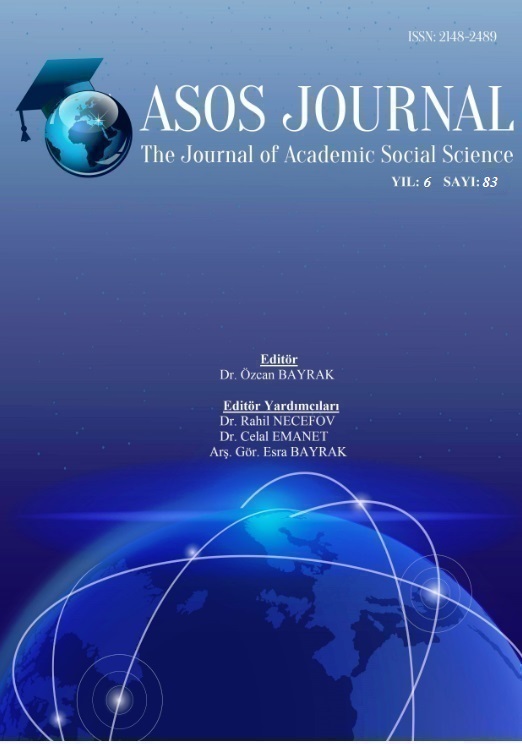Author :
Abstract
Kayseri’nin Develi İlçesi, Sindelhöyük Mahallesi’nde yaşayan Turan Mehmet Söbe (78) son bitkisel örücülük ustasıdır. Bu çalışmada son usta bağlamında, Sindelhöyük’te bitkisel örücülük sanatının günümüzdeki durumunun incelenmesi ve kaybolmaya yüz tutmuş bu sanat dalına karşı bir farkındalık oluşturulması amaçlanmıştır. Bu amaçla, yörede yaşayan son ustadan edinilen bilgiler, çekilen fotoğraflar ve arşiv belgeleri, yapım tekniği, kullanılan araç-gereçler, başlıca ürünler ve bu ürünlerin pazarlanması, ticari değerleri ele alınarak irdelenmiştir. Bitkisel örücülüğün yörede Cumhuriyetten önceye dayanan bir geçmişi bulunduğu, 1975 yılına kadar her evde hasır dokumacılığının yapıldığı, başlıca geçim kaynaklarından biri olduğu anlaşılmaktadır. Eskiden bitkisel örücülük ve hasırcılığın merkezi sayılan Sindelhöyük’de bu sanat, çeşitli nedenlerle günümüze kadar azalarak yok olma noktasına gelmiştir. Usta Turan M. Söbe, ömrü boyunca bitkisel örücülükle geçimini sağlamış, kurslarda bu işi yeni nesle öğretmeye çabalamıştır. Hammadde hasadından, işleme ve hazırlığına, örücülükten pazarlamaya her aşaması ustanın kendisi tarafından yapılmıştır. Uzun yıllar hasır dokumacılığını eşiyle birlikte yürütmüştür. Son on yıldır sadece sepet örücülüğü yapmaktadır. Sindelhöyük’te yaşayan son ustanın üretimi olan ürünler birbirinden farklı çeşitliliktedir. Ustanın bitkisel örücülükte kullandığı araç gereçler de çeşitlidir bunlarla tekniğine uygun olarak sepet örücülüğü yapmaktadır. Ürünlerin kullanım alanları, mobilya, mutfak aracı, aksesuar, yaygı, sepet, kaplama/yalıtım materyali ve diğer amaçlarla kullanımdır. Ustanın kendi tasarımı ve üretimi olan ürünler, evinin bir bölümünde depolanmakta, kişisel çabalarıyla satılmaktadır. Bu bağlamda yörede bitkisel örücülüğün zayıf yönleri ve tehditleri olduğu kadar güçlü yönleri ve kaçırılmaması gereken fırsatları vardır. Bitkisel örücülük, yörede tamamen unutulmadan yeniden canlandırılması gereken bir somut olmayan kültürel mirastır.
Keywords
Abstract
Turan Mehmet Söbe (78), who is living in Sindelhöyük neighborhood of Develi District of Kayseri, is the last basketry master. In this study, it is aimed to examine the current status of the art of basketry in Sindelhöyük in the context of the last master and to create an awareness against this art branch which has been lost. For this purpose, the information obtained from the last master living in the region, photographs and archival documents, construction technique, tools used, major products and marketing of these products, commercial values were examined. It is understood that basketry has a history that goes back to the Republic before, until the year 1975 it was one of the main sources of income and every house is made of rush mat weaving. In Sindelhöyük, formerly considered as the center of basketry and rush mat weaving, this art has come to the point of disappearing until today due to various reasons. Usta Turan M. Söbe has lived on by basketry during his lifetime, and endeavored to teach this art in courses for a new generation. Every stage of basketry, from harvesting of raw materials to processing and preparation, from knitting to marketing is done by the master himself. For many years she has carried out rush mat weaving together with her wife. For the last decade, he has been doing basket weaving only. Products with the production of the last living masters in Sindelhöyük, a different variety from each other. The tools used by the master in herbal knitting are also varied and he is making basket with them in accordance with the technical. Usage areas of products are furniture, kitchen tools, accessories, beams, baskets, coating / insulating materials and other purposes. Products that are the master's own design and production are stored in a part of his house and sold with personal efforts. In this context, plant knitting in the region has weaknesses and threats as well as strengths and opportunities that should not be missed. Plant knitting is an intangible cultural heritage that must be revived without being completely forgotten in the region.





